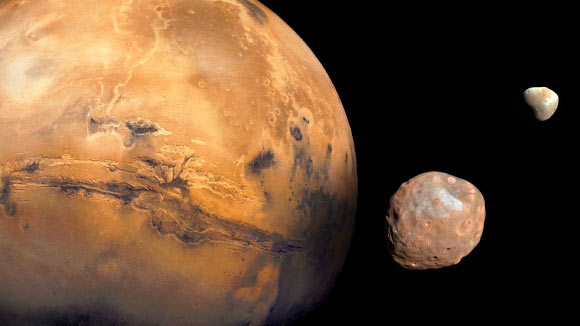Like a teenage diary you can’t throw away, Mars might carry a reminder of its difficult formative years in its tiny moons. A paper published by the Royal Astronomical Society suggests the strangely small Phobos and Deimos could result from a traumatic slingshot rejection of the Red planet from the inner solar system early in its formation, stunting its own growth and removing debris to form a larger moon like our own.
“If Mars formed from a similar process to Earth, why doesn’t it get the same sized moons,” asks Brad Hansen, an astrophysicist at UCLA.
In fact, our own moon is around 1,000 times the size of the red planet’s companions. Some have hypothesized they might be captured asteroids, an idea backed up by their irregular shape and similarity in color to the outer main belt asteroids. However, their near-circular orbit around the planet’s equatorial plane is more in keeping with impact-derived moons like our own.
This dichotomy between appearance and orbit has split the community. Hansen himself leans towards the ‘impactor’ camp, though has spent most of his career looking at other solar systems far beyond our own. Out here he and the exoplanet community have had their eyes opened to the orbital chaos of young planetary systems with exoplanets thrown inwards and out in games of gravitational billiards.
This scenario contrasts starkly with the traditionally held, more serene scene imagined for the formation of our own local community of terrestrial planets, with each growing very near their current location.
However, for a group of planets thought to result from broadly the same collisional accumulation process, striking, unexplainable differences, such as the uneven distribution of moons, and Mars’ low mass compared to the Earth, have inspired recent predictions of more violent beginnings.
“Normally people assume there is a smooth distribution of mass and things don’t move around much, but in exoplanet studies we have seen planetary system are much more dynamically active,” says Hansen.
As far back as 2009 Hansen described an alternative narrative for our inner solar system, supported and built on by other since. It sees all the terrestrial planets seeded in a narrow zone inside Earth’s present orbit, before Mars is thrown outwards by the same gravitational effects seen in other solar systems.
“It’s the gravitational slingshot idea NASA uses for its spacecraft. Two objects pull together, pass each other and this amounts to a deflection.”
Once thrown out closer to its current location Mars was starved of material to accrete, explains Hansen, leaving a ‘surviving planetary embryo’ with a tenth of the mass of Earth and Venus.
As support for the embryo Mars theory has grown Hansen wondered if the process of Martian ‘teenage rejection’ could also account for its strangely small moons.
“Most previous models say here is Mars and here is an impactor, but this alone gives much larger moons than we see. In reality this moon formation is taking place in an evolving context of planets clearing and scattering rubble.”
So Hansen ran new simulations, 60 in total, of our inner solar system’s early history of planetary embryo collisions and gravitational interactions over its first 100 million years.
The first aim was to create systems that delivered a ‘Mars’ with approximate physical and orbital properties. 22/60 of the simulated systems delivered.
Hansen then set out to quantify the gravitational disturbance experienced by an impact generated debris disk around his Mars analogues during their slingshot out of the Earth and Venus’ zone of peak planetary growth. This proto-moon disc material was represented by 500 simulated particles placed into circular orbits around their planet.
Could this process of rejection erode the debris disk to produce Phobos and Deimos? And which of the ‘impactor’ or ‘capturist’ camps would be most happy with the results?
First of all, Hansen found if the moons were impact formed, this episode frequently occurred in the first 10 million of years of planetary accretion, 100 million years before the majority of planetary debris has been scooped up by the growing embryo planets. This provides a substantial period for gravitational perturbations, themselves enhanced by the slingshot rejection, to substantially whittle down the disc material.
However, the capturists could also take solace from Hansen’s work.
Some of the simulations saw the level of perturbation completely erode the proto-moon discs. In these scenarios a series of late close passages with other embryos offers lots of opportunity for so-called three-body capture of the last pieces of solar system detritus. Opportunities not as common in the traditional scenario where Mars accretes more-or-less in situ.
“The argument for a migrating Mars is not based on any slam dunk piece of evidence,” concludes Hansen.
“It is more like the accumulation of circumstantial evidence. It can explain the low mass and the short geochemical age naturally. The moon argument could be another piece.”
Source: Sci News

































Leave a Comment
You must be logged in to post a comment.